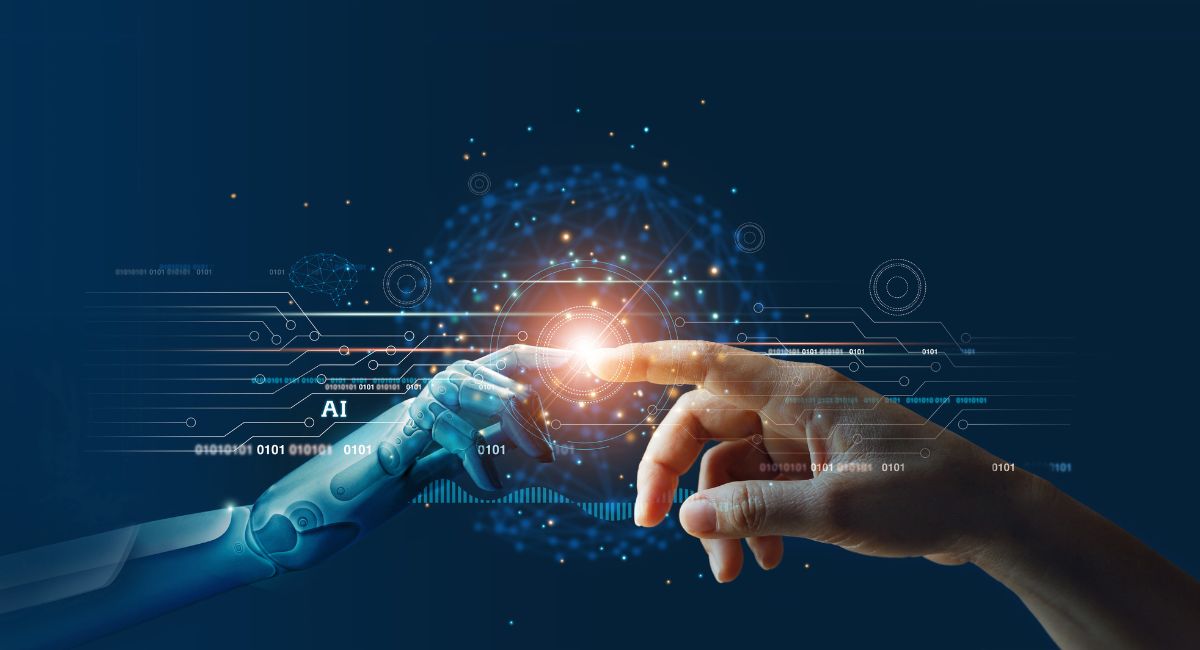How Will Advances In Machine Learning And Artificial Intelligence Change The Way We Interact With Computer
Machine learning and artificial intelligence (AI) are revolutionizing the way we interact with computers. These technologies are enabling computers to become more intelligent, adaptive, and capable of learning from our interactions with them. They have already made significant strides in various applications, such as voice-activated assistants, chatbots, and recommendation systems. In this response, we will delve into the topic of machine learning and AI, exploring their transformative impact on human-computer interaction and the ways they are reshaping our digital experiences.
Understanding Machine Learning and Artificial Intelligence:
Machine learning is a subset of AI that focuses on developing algorithms and models that enable computers to learn and make predictions or decisions without being explicitly programmed. It involves training a computer system to recognize patterns and correlations within data and use them to make informed predictions or take appropriate actions. On the other hand, artificial intelligence refers to the broader concept of creating intelligent machines that can simulate human-like intelligence and behavior.
Machine Learning’s Impact on Human-Computer Interaction:
Machine learning and AI have significantly enhanced the capabilities of computers, allowing them to interpret, understand, and respond to human input in more sophisticated ways. They are changing the dynamics of human-computer interaction by enabling computers to adapt to the needs and preferences of individual users, resulting in more personalized and intuitive experiences. Here are some key aspects highlighting their impact:
1. Natural Language Processing: Natural language processing (NLP) is a subfield of AI that focuses on enabling computers to understand and interpret human language. Machine learning algorithms have played a crucial role in advancing NLP, allowing computers to comprehend and respond to human speech or text inputs. This has led to the development of voice-activated assistants like Siri, Google Assistant, and Amazon Alexa, which have become integral parts of our daily lives.
2. Chatbots and Virtual Assistants: Chatbots are computer programs that use AI and machine learning techniques to simulate human-like conversations with users. They have become increasingly prevalent in customer service, providing instant responses and support. By leveraging machine learning, chatbots can continuously improve their performance by learning from interactions with users and refining their responses over time.
3. Personalized Recommendations: Machine learning algorithms have transformed how computers recommend products, services, and content to users. Platforms such as Netflix, Amazon, and Spotify use AI to analyze user behavior, preferences, and historical data to provide personalized recommendations. By learning from our interactions and patterns, these algorithms improve their accuracy and enhance our overall user experience.
4. Image and Speech Recognition: Machine learning has enabled significant advancements in image and speech recognition technologies. Computers can now accurately identify and interpret visual and auditory inputs, leading to applications such as facial recognition, object detection, and voice-controlled interfaces. These technologies have a wide range of applications, from self-driving cars to medical imaging and accessibility features.
5. Intelligent Automation: AI and machine learning are transforming automation by making systems more intelligent and adaptable. Robotic Process Automation (RPA) combined with machine learning allows computers to automate repetitive tasks, analyze large volumes of data, and make informed decisions. This integration increases efficiency, reduces errors, and frees up human resources for more complex and creative tasks.
Also, read – The Intersection of Machine Learning and NFT Gaming: Implication And Potential
How advances in machine learning and AI will continue to change the way we interact with computers in the future
Advances in machine learning and artificial intelligence (AI) are transforming the way we interact with computers and will continue to do so in the future. These technological advancements are enabling computers to understand and respond to human input in more natural and intuitive ways. Here, we will discuss some key areas where these changes are occurring.
1. Natural Language Processing (NLP): NLP is an area of AI that focuses on the interaction between computers and human language. Recent advancements in NLP, powered by machine learning algorithms, have made significant strides in enabling computers to understand and generate human language. This progress is evident in voice assistants like Siri, Google Assistant, and Alexa, which can understand and respond to voice commands, answer questions, and perform tasks. In the future, NLP will become even more refined, allowing for more complex conversations and more accurate understanding of context and nuances.
2. Computer Vision: Computer vision is another field that has seen remarkable progress due to machine learning and AI. Computers can now analyze and interpret visual data, such as images and videos, with impressive accuracy. This has led to applications like facial recognition, object detection, and image classification becoming commonplace. In the future, computer vision technologies will continue to improve, enabling computers to understand visual data in more sophisticated ways. This will have a profound impact on areas such as autonomous vehicles, surveillance systems, and augmented reality.
Today Apple launched several products that use AI and machine learning algorithms. They avoided the word “AI”.
I made a diagram for you to understand the relationship between Computer Science, Data Science, Artificial Intelligence (AI), Machine Learning (ML), and Deep Learning… pic.twitter.com/nSy0MwfG4O
— Kris Kashtanova (@icreatelife) June 5, 2023
3. Personalized Recommendations: Machine learning algorithms are adept at analyzing large volumes of data to extract patterns and make predictions. This capability has transformed the way we receive personalized recommendations in various domains. Companies like Amazon, Netflix, and Spotify use sophisticated recommendation systems to suggest products, movies, and music based on individual preferences and behavior. As AI advances, these recommendation systems will become even more accurate and personalized, leading to more tailored experiences across different industries.
4. Automation and Autonomous Systems: The integration of machine learning and AI has paved the way for automation and autonomous systems. Industries like manufacturing, transportation, and logistics are adopting robotics and AI technologies to automate repetitive tasks and improve efficiency. Self-driving cars and drones are examples of autonomous systems that rely on machine learning algorithms to perceive and navigate the world. In the future, we can expect more widespread automation, leading to increased productivity and new job opportunities in emerging fields.
5. Natural User Interfaces: Advances in AI are driving the development of natural user interfaces (NUIs) that allow humans to interact with computers in more intuitive ways. Touchscreens, gesture recognition, and voice commands are examples of NUIs that are already widely used. As AI algorithms become more sophisticated, NUIs will become more seamless and responsive, enabling users to interact with computers using natural movements, gestures, and even thoughts. This could revolutionize fields like healthcare, gaming, and virtual reality, providing more immersive and intuitive experiences.
6. Data Analysis and Decision-Making: Machine learning and AI algorithms excel at analyzing vast amounts of data and extracting valuable insights. In the future, these capabilities will enhance decision-making processes across various domains, including finance, healthcare, and business. AI-powered systems will assist in analyzing complex data sets, identifying patterns, and making data-driven predictions. This will lead to more informed decision-making, improved efficiency, and the ability to address complex problems with greater accuracy.
7. Personal Assistants and Chatbots: Virtual personal assistants and chatbots are becoming increasingly prevalent in our daily lives. These AI-powered conversational agents can answer questions, provide recommendations, and assist with various tasks. As AI continues to advance, personal assistants and chatbots will become more intelligent, understanding context, emotions, and natural language with greater accuracy. They will become personalized companions, providing proactive support and assisting with a wide range of activities.
Benefits of these revolutionary changes
The advancements in machine learning and AI technologies offer numerous potential benefits that can significantly enhance various aspects of our lives. Here are some of the key advantages of these changes:
1. Increased Productivity: Machine learning and AI can automate repetitive and mundane tasks, allowing humans to focus on more complex and creative endeavors. By leveraging intelligent algorithms, businesses can streamline their operations, resulting in increased productivity and efficiency. For example, automated data analysis can rapidly process large datasets, providing valuable insights and enabling faster decision-making. This improved productivity can lead to cost savings, better resource allocation, and accelerated innovation.
2. Improved Efficiency: AI-powered systems have the ability to optimize processes and workflows, leading to improved efficiency across multiple industries. Machine learning algorithms can analyze and learn from data patterns, enabling systems to identify bottlenecks, streamline operations, and reduce errors. For instance, in manufacturing, AI-based predictive maintenance can monitor equipment performance, detect potential failures in advance, and schedule maintenance proactively. This minimizes downtime, reduces costs, and maximizes production efficiency.
3. Personalized User Experience: Machine learning algorithms excel at understanding user preferences and behavior patterns. This capability allows for highly personalized user experiences across various applications and platforms. From personalized recommendations in e-commerce and entertainment to customized healthcare plans, AI can tailor services to individual needs. This not only improves user satisfaction but also enhances customer loyalty and engagement. Personalization also extends to user interfaces, where AI can adapt to individual preferences and offer intuitive and seamless interactions.
4. Enhanced Decision-Making: The ability of AI systems to analyze vast amounts of data and extract meaningful insights can significantly enhance decision-making processes. AI algorithms can identify patterns, detect anomalies, and make predictions based on historical and real-time data. This assists businesses and organizations in making informed decisions, mitigating risks, and identifying opportunities. For instance, AI-powered analytics can help financial institutions detect fraudulent activities, healthcare providers identify potential health risks, and marketers target their audience more effectively.
5. Improved Customer Service: AI technologies, such as chatbots and virtual assistants, can provide round-the-clock customer support, responding to inquiries promptly and accurately. These AI-powered agents can handle routine customer queries, provide information, and assist with transactions, freeing up human agents to handle more complex issues. By leveraging natural language processing and machine learning, these systems can understand user intent and deliver personalized and efficient customer service, leading to higher customer satisfaction and loyalty.
6. Advancements in Healthcare: AI has the potential to revolutionize the healthcare industry. Machine learning algorithms can analyze medical data, including patient records, medical images, and genomic data, to assist in accurate diagnosis, personalized treatment plans, and drug discovery. AI-powered monitoring systems can detect early signs of health issues, enabling timely intervention. Robotic surgery assisted by AI can enhance precision and minimize invasiveness. These advancements in healthcare can lead to improved patient outcomes, reduced costs, and more efficient healthcare delivery.
7. Accessibility and Inclusion: AI technologies have the potential to make digital platforms and services more accessible to individuals with disabilities. For example, speech recognition and natural language processing enable voice-controlled interfaces, aiding those with mobility impairments. Computer vision algorithms can assist individuals with visual impairments by interpreting and describing visual content. These advancements promote inclusivity and empower individuals who may face barriers in accessing technology.
It is important to note that while the benefits of AI and machine learning are significant, ethical considerations and responsible development practices should be prioritized. Ensuring transparency, fairness, and accountability in AI systems is crucial to harnessing the full potential of these technologies for the benefit of society.
Challenges that comes with it
While advances in machine learning and AI bring about numerous benefits, they also pose certain challenges that need to be addressed. Here are some of the key challenges associated with these changes:
1. Job Displacement: One of the primary concerns is the potential displacement of jobs. As automation and AI technologies become more prevalent, certain tasks and roles traditionally performed by humans may be automated, leading to job losses in specific industries. This can cause economic disruption and require workers to acquire new skills to remain relevant in the evolving job market. However, it is important to note that while some jobs may be replaced, new job opportunities can emerge in areas related to AI development, implementation, and maintenance.
2. Privacy Concerns: The proliferation of AI and machine learning often relies on collecting and analyzing large amounts of personal data. This raises concerns regarding privacy and data protection. AI systems need access to significant amounts of data to train and improve their performance. However, if not handled carefully, there is a risk of unauthorized access, data breaches, and the misuse of personal information. Striking a balance between data collection for AI advancements and protecting individuals’ privacy is a crucial challenge that needs to be addressed through robust regulations and responsible data handling practices.
3. Bias in Machine Learning Algorithms: Machine learning algorithms learn from historical data, and if the training data contains biases, the algorithms may perpetuate and amplify those biases. This can lead to unfair or discriminatory outcomes, particularly in areas such as hiring, loan approvals, and criminal justice. Addressing bias in AI systems requires careful attention to the data used for training, regular monitoring and auditing of algorithms, and diverse and inclusive teams involved in their development. Efforts are being made to improve fairness and mitigate bias, but it remains an ongoing challenge.
4. Ethical Decision-Making: AI systems are increasingly being entrusted with making decisions that have significant consequences, such as autonomous vehicles making split-second choices on the road or healthcare algorithms suggesting treatment plans. Ensuring that these systems make ethical decisions is a complex challenge. It involves defining ethical guidelines, understanding societal values, and embedding ethical considerations into the design and development of AI systems. It is important to address questions of accountability, transparency, and the potential impacts on human well-being.
5. Lack of Interpretability and Explainability: Deep learning algorithms, which are often at the core of many AI applications, can be highly complex and difficult to interpret. This lack of interpretability raises concerns, particularly in critical domains where decisions need to be explainable and justifiable. For instance, in healthcare, it is crucial to understand the reasoning behind a diagnosis or treatment recommendation. Efforts are being made to develop methods that provide explanations and insights into AI decision-making processes, enhancing trust and understanding.
6. Technical Limitations and Overreliance: AI technologies, while impressive, still have limitations. They are not infallible and can produce incorrect results or make flawed predictions, especially when faced with unfamiliar or outlier situations. Additionally, AI systems require significant computational resources, which can pose challenges in terms of scalability and accessibility. It is important to recognize the limitations of AI and ensure that human oversight and intervention are maintained in critical decision-making processes.
Addressing these challenges requires a multi-faceted approach involving collaboration among researchers, policymakers, industry stakeholders, and the public. Striking a balance between technological advancements and ethical considerations is essential to ensure that AI and machine learning technologies are developed and deployed in a manner that benefits society as a whole.
Top 10 Examples of AI and Machine learning
Some examples of how advances in machine learning and AI are already changing the way we interact with computers
- Self-driving cars: Self-driving cars use AI and machine learning to navigate the road without human input. They use sensors like cameras, radar, and lidar to create a 360-degree view of their surroundings, and they use algorithms to make decisions about how to drive safely.
- Virtual assistants: Virtual assistants like Amazon Alexa and Google Assistant use AI and machine learning to understand our voice commands and respond to our questions. They can also learn our preferences and habits over time, so they can become more helpful and personalized.
- Fraud detection: AI and machine learning are used by banks and other financial institutions to detect fraudulent transactions. They can analyze large amounts of data to identify patterns that are associated with fraud, and they can flag suspicious transactions for manual review.
- Product recommendations: AI and machine learning are used by e-commerce websites to recommend products to customers. They can analyze customer purchase history, browsing behavior, and search history to identify products that customers are likely to be interested in.
- Medical diagnosis: AI and machine learning are used by doctors and other healthcare professionals to diagnose diseases. They can analyze medical images and data to identify patterns that are associated with different diseases, and they can help doctors to make more accurate diagnoses.
- Personalized marketing: AI and machine learning are used by marketers to target their marketing campaigns to specific groups of people. They can analyze customer data to identify their interests and demographics, and they can use this information to create targeted ads and marketing materials.
- Risk assessment: AI and machine learning are used to assess risk in a variety of industries, including finance, insurance, and healthcare. They can analyze data to identify patterns that are associated with risk, and they can use this information to make predictions about the likelihood of future events.
- Natural language processing: Natural language processing (NLP) is a field of computer science that deals with the interaction between computers and human language. AI and machine learning are used in NLP to develop systems that can understand and process human language.
- Computer vision: Computer vision is a field of computer science that deals with the automatic analysis of digital images and videos. AI and machine learning are used in computer vision to develop systems that can identify objects, faces, and other features in images and videos.
- Robotics: Robotics is a field of engineering that deals with the design, construction, and operation of robots. AI and machine learning are used in robotics to develop robots that can sense their environment, make decisions, and take actions without human input.
These are just a few of the many ways that AI and machine learning are being used today. As these technologies continue to develop, we can expect to see even more innovative and impactful applications in the future.
Stay informed with daily updates from Blockchain Magazine on Google News. Click here to follow us and mark as favorite: [Blockchain Magazine on Google News].
Get Blockchain Insights In Inbox
Stay ahead of the curve with expert analysis and market updates.
latest from tech
Disclaimer: Any post shared by a third-party agency are sponsored and Blockchain Magazine has no views on any such posts. The views and opinions expressed in this post are those of the clients and do not necessarily reflect the official policy or position of Blockchain Magazine. The information provided in this post is for informational purposes only and should not be considered as financial, investment, or professional advice. Blockchain Magazine does not endorse or promote any specific products, services, or companies mentioned in this posts. Readers are encouraged to conduct their own research and consult with a qualified professional before making any financial decisions. The featured image used is just a creative depiction of the title and it does not intend to hurt sentiments of any person or institution. If it hurts anyone sentiments, please do not hesitate to reach out to Blockchain Magazine.

 Bitcoin
Bitcoin  Ethereum
Ethereum  XRP
XRP  Tether
Tether  Solana
Solana  Dogecoin
Dogecoin  USDC
USDC  Cardano
Cardano  Lido Staked Ether
Lido Staked Ether  TRON
TRON  Chainlink
Chainlink  Avalanche
Avalanche  Wrapped stETH
Wrapped stETH  Stellar
Stellar  Wrapped Bitcoin
Wrapped Bitcoin  Sui
Sui  Hedera
Hedera  Toncoin
Toncoin  Shiba Inu
Shiba Inu  WETH
WETH  Polkadot
Polkadot  Parkcoin
Parkcoin  LEO Token
LEO Token  Litecoin
Litecoin  Bitcoin Cash
Bitcoin Cash  Bitget Token
Bitget Token  Uniswap
Uniswap  Official Trump
Official Trump  Hyperliquid
Hyperliquid  Wrapped eETH
Wrapped eETH  Pepe
Pepe  USDS
USDS  NEAR Protocol
NEAR Protocol  Ethena USDe
Ethena USDe  Aave
Aave  Aptos
Aptos  Internet Computer
Internet Computer  Ondo
Ondo  Ethereum Classic
Ethereum Classic  Monero
Monero  POL (ex-MATIC)
POL (ex-MATIC)  OKB
OKB  Cronos
Cronos  Mantle
Mantle  Dai
Dai  Algorand
Algorand  MANTRA
MANTRA  Render
Render 




